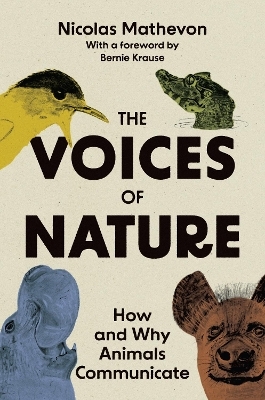
The Voices of Nature
How and Why Animals Communicate
Seiten
2023
Princeton University Press (Verlag)
978-0-691-23675-9 (ISBN)
Princeton University Press (Verlag)
978-0-691-23675-9 (ISBN)
Songs, barks, roars, hoots, squeals, and growls: exploring the mysteries of how animals communicate by sound
What is the meaning of a bird’s song, a baboon’s bark, an owl’s hoot, or a dolphin’s clicks? In The Voices of Nature, Nicolas Mathevon explores the mysteries of animal sound. Putting readers in the middle of animal soundscapes that range from the steamy heat of the Amazon jungle to the icy terrain of the Arctic, Mathevon reveals the amazing variety of animal vocalizations. He describes how animals use sound to express emotion, to choose a mate, to trick others, to mark their territory, to call for help, and much more. What may seem like random chirps, squawks, and cries are actually signals that, like our human words, allow animals to carry on conversations with others.
Mathevon explains how the science of bioacoustics works to decipher the ways animals make and hear sounds, what information is encoded in these sound signals, and what this information is used for in daily life. Drawing on these findings as well as observations in the wild, Mathevon describes, among many other things, how animals communicate with their offspring, how they exchange information despite ambient noise, how sound travels underwater, how birds and mammals learn to vocalize, and even how animals express emotion though sound. Finally, Mathevon asks if these vocalizations, complex and expressive as they are, amount to language.
For readers who have wondered about the meaning behind a robin’s song or cicadas’ relentless “tchik-tchik-tchik,” this book offers a listening guide for the endlessly varied concert of nature.
What is the meaning of a bird’s song, a baboon’s bark, an owl’s hoot, or a dolphin’s clicks? In The Voices of Nature, Nicolas Mathevon explores the mysteries of animal sound. Putting readers in the middle of animal soundscapes that range from the steamy heat of the Amazon jungle to the icy terrain of the Arctic, Mathevon reveals the amazing variety of animal vocalizations. He describes how animals use sound to express emotion, to choose a mate, to trick others, to mark their territory, to call for help, and much more. What may seem like random chirps, squawks, and cries are actually signals that, like our human words, allow animals to carry on conversations with others.
Mathevon explains how the science of bioacoustics works to decipher the ways animals make and hear sounds, what information is encoded in these sound signals, and what this information is used for in daily life. Drawing on these findings as well as observations in the wild, Mathevon describes, among many other things, how animals communicate with their offspring, how they exchange information despite ambient noise, how sound travels underwater, how birds and mammals learn to vocalize, and even how animals express emotion though sound. Finally, Mathevon asks if these vocalizations, complex and expressive as they are, amount to language.
For readers who have wondered about the meaning behind a robin’s song or cicadas’ relentless “tchik-tchik-tchik,” this book offers a listening guide for the endlessly varied concert of nature.
Nicolas Mathevon is Distinguished Professor of Neurosciences and Animal Behavior at the University of Saint-Etienne, senior member of the Institut universitaire de France, member of Academia Europaea, and president of the International Bioacoustics Society. He is also a former visiting Miller Professor at the University of California, Berkeley, and a former visiting professor at Hunter College, City University of New York.
| Erscheinungsdatum | 04.07.2023 |
|---|---|
| Vorwort | Bernard L. Krause |
| Zusatzinfo | 32 b/w illus. |
| Verlagsort | New Jersey |
| Sprache | englisch |
| Maße | 156 x 235 mm |
| Themenwelt | Geisteswissenschaften ► Psychologie |
| Naturwissenschaften ► Biologie ► Humanbiologie | |
| Naturwissenschaften ► Biologie ► Ökologie / Naturschutz | |
| Naturwissenschaften ► Biologie ► Zoologie | |
| ISBN-10 | 0-691-23675-5 / 0691236755 |
| ISBN-13 | 978-0-691-23675-9 / 9780691236759 |
| Zustand | Neuware |
| Informationen gemäß Produktsicherheitsverordnung (GPSR) | |
| Haben Sie eine Frage zum Produkt? |
Mehr entdecken
aus dem Bereich
aus dem Bereich
Wie Myrmecophile mit ihren Wirten interagieren
Buch | Softcover (2023)
Springer (Verlag)
69,99 €
23 Techniken, um Stress abzubauen, Negativspiralen zu unterbrechen …
Buch | Softcover (2023)
FinanzBuch Verlag
18,00 €
produktiv sein ohne Stress – und mehr vom Leben haben
Buch | Softcover (2023)
dtv Verlagsgesellschaft
18,00 €


